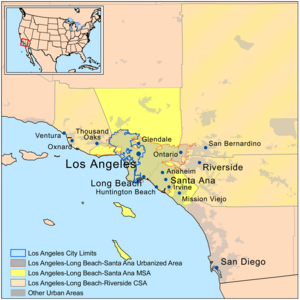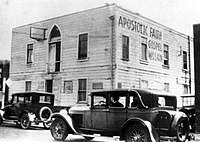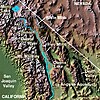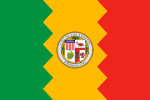Portal:Greater Los Angeles
The Greater Los Angeles Portal Greater Los Angeles is the most populous metropolitan area in the U.S. state of California, encompassing five counties in Southern California extending from Ventura County in the west to San Bernardino County and Riverside County in the east, with Los Angeles County in the center, and Orange County to the southeast. The Los Angeles–Anaheim–Riverside combined statistical area (CSA) covers 33,954 square miles (87,940 km2), making it the largest metropolitan region in the United States by land area. The contiguous urban area is 2,281 square miles (5,910 km2), whereas the remainder mostly consists of mountain and desert areas. With a population of 18.4 million in 2024, it is the second-largest metropolitan area in the country, behind New York, as well as one of the largest megacities in the world. In addition to being the nexus of the global entertainment industry, including films, television, and recorded music, Greater Los Angeles is also an important center of international trade, education, media, business, tourism, technology, and sports. It is the third-largest metropolitan area by nominal GDP in the world with an economy exceeding $1 trillion in output, behind New York City and Tokyo. There are three contiguous component urban areas in Greater Los Angeles: the Inland Empire, which can be broadly defined as Riverside and San Bernardino counties; the Ventura/Oxnard metropolitan area (Ventura County); and the Los Angeles metropolitan area (also known as Metropolitan Los Angeles or Metro LA) consisting of Los Angeles and Orange counties only. The Census Bureau designates the latter as the Los Angeles–Long Beach–Anaheim metropolitan statistical area (MSA), the fourth largest metropolitan area in the western hemisphere and the second-largest metropolitan area in the United States, by population of 13 million as of the 2020 U.S. census. It has a total area of 4,850 square miles (12,561 km2). Although San Diego–Tijuana borders the Greater Los Angeles area at San Clemente and Temecula, it is not part of it as the two urban areas are not geographically contiguous due to the presence of Camp Pendleton. However, both form part of the Southern California Megalopolis which extends into Tijuana, Baja California, Mexico. Throughout the 20th century, Greater Los Angeles was one of the fastest-growing regions in the United States, but growth has slowed since 2000. (Full article...) Selected article - The Azusa Street Revival was a historic Pentecostal revival meeting that took place in Los Angeles, California and is the origin of the Pentecostal movement. It was led by William J. Seymour, an African American preacher. It began with a meeting on April 9, 1906, and continued until roughly 1915. The revival was characterized by ecstatic spiritual experiences accompanied by miracles, dramatic worship services, speaking in tongues, and inter-racial mingling. The participants were criticized by the secular media and Christian theologians for behaviors considered to be outrageous and unorthodox, especially at the time. Today, the revival is considered by historians to be the primary catalyst for the spread of Pentecostalism in the 20th century. Did You Know -
March - June 2004 Selected imageWikiProject
Related PortalsSelected biography - Caroline Agnes Brady (also known as Caroline Agnes Von Egmont Brady; October 3, 1905 – November 5, 1980) was an American philologist who specialised in Old English and Old Norse works. Her works included the 1943 book The Legends of Ermanaric, based on her doctoral dissertation, and three influential papers on the Anglo-Saxon poem Beowulf. She taught at the University of California, Berkeley, the University of Pennsylvania, Johns Hopkins University, and Harvard University, among other places. Brady was born an American citizen in Tientsin, China, and traveled frequently as a child, spending time in Los Angeles, California, British Columbia, and Austin, Texas. She studied in the University of California system, receiving her bachelor's and master's degrees, and her Ph.D. in 1935. She next became an English instructor at that university's College of Agriculture, and worked as an assistant professor of languages and literature at Berkeley from 1941 to 1946. The following three years were spent at the University of Pennsylvania, until, at the end of 1949, Brady moved to teach at Central Oregon Community College; her resignation due to "ill health" was announced a few months later. After being named the 1952–53 Marion Talbot Fellow of the American Association of University Women and writing two articles, Brady's scholarship ceased for a quarter of a century. In 1979, and posthumously in 1983, her final two articles were published. (Full article...)Regions, major cities and districtsRegions
Cities
Cities by countyTopicsCategoriesSelect [►] to view subcategories
Greater Los Angeles
Los Angeles County, California
Orange County, California
Ventura County, California
WikimediaThe following Wikimedia Foundation sister projects provide more on this subject:
Discover Wikipedia using portals |









































